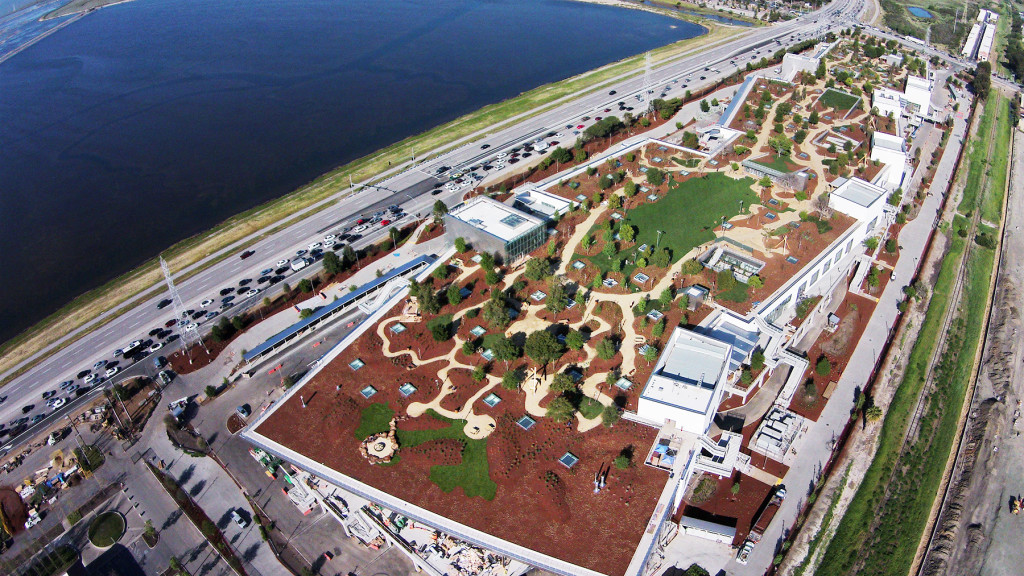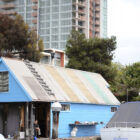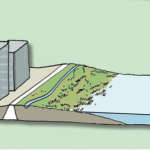Cities and counties working to revise obsolete land-use plans based on inconsistent flood maps
The San Francisco Public Press surveyed 13 Bay Area cities and counties where building projects are planned in waterfront areas vulnerable to sea level rise. While most are studying the issue, few have passed new regulations to limit growth or require developers to floodproof their properties.
The results show a huge gap between awareness of the threats of climate change and concrete action to protect vulnerable waterfront communities in coming decades.
Reviewing published reports of plans for largescale commercial and residential construction projects across the Bay Area, we focused on San Francisco, plus five other counties and seven cities where the most intense development has entered the permitting process.
In the chart below, we graded governments by their level of response to the threat of sea level rise.
All cities and counties responded that they were studying and planning, but fewer than half had completed vulnerability assessments. Two completed the drafting of an action plan. But carrying out changes, such as setting new zoning or landuse rules for private development, proved more of a challenge.
We also determined whether each government’s statemandated climate action plan addresses sea level rise, and whether it had maps showing where future flooding was likely to occur.
Among the findings:
- Only six of 13 governments have gone beyond studying the problem.
- None has adopted a sea level rise action plan.
- San Francisco is the first city with a written policy for evaluating public works investment accounting for sea level rise, though the plan does not cover private developments.
- San Jose has made some zoning changes in the bayside community of Alviso, but has fewer rules for elsewhere in the city.
- We were unable to find evidence that any of the governments had calculated the cost to taxpayers of protecting future developments.
- Every government surveyed has some plans to protect or expand coastal wetlands as natural protection.
Cities and counties cite at least three problems that keep them from acting more swiftly. First, while virtually all scientists predict that the bay will rise, nobody knows for sure how by much, or how fast.
“We’re having to do planning where the conditions are continually changing,” said Jack Liebster, planning manager for Marin County. “And water doesn’t really respect city and county boundaries.”
A second problem is that a rising San Francisco Bay will require regional solutions. A fix in one city can worsen flooding down the shore. Third, all the jurisdictions have struggled to fund environmental plans.
“Getting people to think about longrange problems, when they don’t even know how to fill the potholes today, is difficult,” said Brian Beveridge, codirector of the West Oakland Environmental Indicators Project, an environmental justice organization. “We’re at the beginning of a longterm public discussion that’s going to be tough, frankly,” Beveridge added. “It’s going to fall down along lines of class and political power — who will be protected and who will be thrown to the dogs.”
Counties
San Francisco:
| studying the effects of sea level rise | hazard inventory complete | drafted adaptation or mitigation plan | builders required to respond to sea rise threat |
Status: Capital Planning Committee has issued guidelines to assess sea level risk in publicly funded construction. Planning Department, which regulates private development, may suggest changes to building codes in the next few years.
Key Actions:
- Port of San Francisco projected food risk for 2050 and 2100
- Studying multibillion-dollar sewer upgrade to prepare for rising seas
- Mission Creek vulnerability study coming this year
- Developed plan to protect structures at Ocean Beach
- Formed interdepartmental coordinating committee on sea level rise
Alameda:
| studying the effects of sea level rise |
Status: Only county in our survey in which every city has adopted a climate action plan addressing sea level rise. But no countywide plan has been adopted.
Key Actions:
- Currently assessing vulnerability and protection strategies with regional agencies
- Three cities — Alameda, Berkeley and Oakland — got Rockefeller Foundation funding to hire “resiliency” officers
Marin:
| studying the effects of sea level rise | hazard inventory complete |
Status: Developing plans to build up degraded wetlands, while abandoning some vulnerable land to San Francisco Bay. “The time is really right,” said Planning Manager Jack Liebster. “The community is really asking for this now. It’s not just staff saying we need to do this.”
Key Actions:
- Completed more than 20 projects to adapt to sea level rise and extreme storms
- Seeking funding for countywide vulnerability assessment
San Mateo:
| studying the effects of sea level rise | hazard inventory complete |
Status: With $24 billion in property and contents at risk from extreme sea level rise flooding, the most of any West Coast county, 110,000 people may be at risk, a Pacific Institute study found.
Key Actions:
- Published vulnerability assessment in 2011
- Hosted workshops introducing representatives from all 20 cities to federal, state and local experts
Santa Clara:
| studying the effects of sea level rise | hazard inventory complete | revised local flooding maps |
Status: Creating a complex tool to estimate the economic effects of ignoring sea level rise, which can be shared with other counties. Demetra McBride, director of sustainability, said: “Everyone is looking at the cost of measures, and that can be daunting. What no one was really looking at was the cost of inaction.”
Key Actions:
- Largest salt pond habitat restoration project in the Western U.S.
- Studying vulnerability of water supply and wastewater systems
Solano:
| studying the effects of sea level rise |
Status: Working with cities to study sea level rise risk in the Sacramento River Delta area. Benicia is set to present a Carquinez Strait adaptation plan, said environmental consultant Alex Porteshawver.
Key Actions:
- Published sea level rise study in 2010 and strategic plan in 2011
- Suisun Marsh restoration will limit threat to water quality and marshlands
Cities:
Burlingame:
| studying the effects of sea level rise |
Status: A very low-lying, vulnerable community. Climate Central’s online tool shows that 30 percent of the city would be inundated if foods reached 8 feet.
Key Actions:
- The city’s general plan will soon be revised to include projections and proposed mitigation for sea level rise
Hayward:
| studying the effects of sea level rise |
Status: City has vast expanses of marshes and open space, so it has focused on strengthening natural barriers. “People are interested in sea level rise and they know it’s important,” said Maggie Wenger of the Bay Conservation and Development Commission.
Key Actions:
- Produced resilience study in 2014, now part of the general plan
- Environmental Services Manager Erik Pearson said city is evaluating where to protect shores and where to “allow nature to take its course”
Menlo Park:
| studying the effects of sea level rise |
Status: New general plan will likely include zoning updates for waterfront that may address sea level rise specifically, senior planner Deanna Chow said.
Key Actions:
- Will revise general plan by June 2016
- Working with neighboring cities to fortify levees and protect San Francisquito Creek area
Mountain View:
| studying the effects of sea level rise | hazard inventory complete | revised local flooding maps | builders required to respond to sea rise threat |
Status: Hosts tech giants LinkedIn, Google, Microsoft and Intuit. City Council in May gave Google only a quarter of the new 2.2 million square feet available in the North Bayshore zone. A 2014 city plan discusses strategies including retreat, requiring developers to build higher and encouraging “adaptive planning” such as levees.
Key Actions:
- Developed a study that evaluates and creates cost estimates for protecting the city’s low-lying shoreline community most at risk
- The city recently proposed to build a seawall to protect North Bayshore developments
Oakland:
| studying the effects of sea level rise |
Status: West Oakland Environmental Indicators Project worked with other groups to study sea level rise and social equity. “This city, like most, is still assessing which institutions and facilities need to be protected,” said co-director Brian Beveridge.
Key Actions:
- Port of Oakland is raising facilities above projected sea level rise
- Hired Victoria Salinas as chief resiliency officer to coordinate response to rising bay waters
Redwood City:
| studying the effects of sea level rise |
Status: Facing complications of massive development in the at-risk bayside area of Redwood Shores, where Dreamworks and EA Sports are currently constructing new offices. The city is planning for sea level rise of 3 feet.
Key Actions:
- Environmental Protection Agency in March stepped into the dispute over whether old Cargill salt ponds fall under U.S. jurisdiction
- One opponent, Save the Bay, proposing alternative plan to build a 3-mile levee and restore 100,000 acres of marshland
San Jose:
| studying the effects of sea level rise | hazard inventory complete | drafted adaptation or mitigation plan | builders required to respond to sea rise threat |
Status: Designed “food risk management levees” to protect the community of Alviso, a wastewater facility and other low-lying lands, according to the Planning Department’s Whitney Berry.
Key Actions:
- South Bay Shoreline Study and Salt Pond Restoration Project evaluated food risk, and proposed levee improvements
- Some developments placed in floodplain management area, where all occupied floors must be above 100-year flood level










